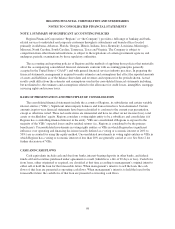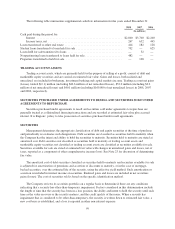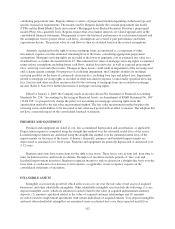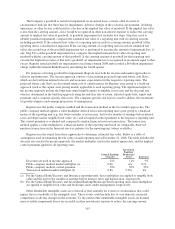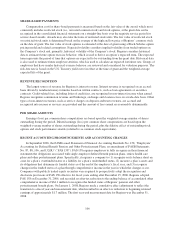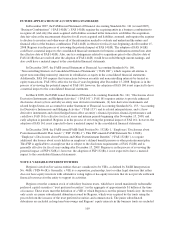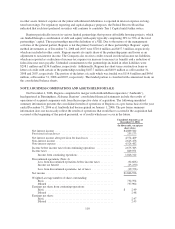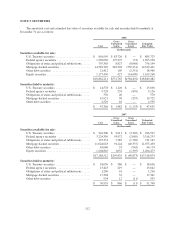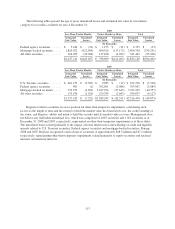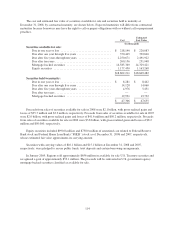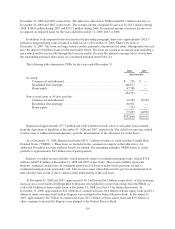Regions Bank 2008 Annual Report Download - page 116
Download and view the complete annual report
Please find page 116 of the 2008 Regions Bank annual report below. You can navigate through the pages in the report by either clicking on the pages listed below, or by using the keyword search tool below to find specific information within the annual report.SHARE-BASED PAYMENTS
Compensation cost for share-based payments is measured based on the fair value of the award, which most
commonly includes restricted stock (i.e., unvested common stock) and stock options, at the grant date and is
recognized in the consolidated financial statements on a straight-line basis over the requisite service period for
service-based awards. Awards may also take the form of restricted stock units. The fair value of restricted stock
or restricted stock units is determined based on the average of the high and low price of Regions’ common stock
on the date of grant. The fair value of stock options is estimated at the date of grant using a Black-Scholes option
pricing model and related assumptions. Expected volatility considers implied volatility from traded options on
the Company’s stock and, primarily, historical volatility of the Company’s stock. Regions considers historical
data to estimate future option exercise behavior, which is used to derive an option’s expected term. The expected
term represents the period of time that options are expected to be outstanding from the grant date. Historical data
is also used to estimate future employee attrition, which is used to calculate an expected forfeiture rate. Groups of
employees that have similar historical exercise behavior are reviewed and considered for valuation purposes. The
risk-free rate is based on the U.S. Treasury yield curve in effect at the time of grant and the weighted-average
expected life of the grant.
REVENUE RECOGNITION
The largest source of revenue for Regions is interest revenue. Interest revenue is recognized on an accrual
basis driven by nondiscretionary formulas based on written contracts, such as loan agreements or securities
contracts. Credit-related fees, including letter of credit fees, are recognized in non-interest income when earned.
Regions recognizes commission revenue and brokerage, exchange and clearance fees on a trade-date basis. Other
types of non-interest revenues, such as service charges on deposits and trust revenues, are accrued and
recognized into income as services are provided and the amount of fees earned are reasonably determinable.
PER SHARE AMOUNTS
Earnings (loss) per common share computations are based upon the weighted-average number of shares
outstanding during the period. Diluted earnings (loss) per common share computations are based upon the
weighted-average number of shares outstanding during the period, plus the dilutive effect of outstanding stock
options and stock performance awards (referred to as common stock equivalents).
RECENT ACCOUNTING PRONOUNCEMENTS AND ACCOUNTING CHANGES
In September 2006, the FASB issued Statement of Financial Accounting Standards No. 158, “Employers’
Accounting for Defined Benefit Pension and Other Postretirement Plans, an amendment of FASB Statements
No. 87, 88, 106, and 132(R)” (“FAS 158”). FAS 158 requires employers to fully recognize in their financial
statements the obligations associated with single-employer defined benefit pension plans, retiree health care
plans and other postretirement plans. Specifically, it requires a company to (1) recognize on its balance sheet an
asset for a plan’s overfunded status or a liability for a plan’s underfunded status, (2) measure a plan’s assets and
its obligations that determine its funded status as of the end of the employer’s fiscal year, and (3) recognize
changes in the funded status of a plan through comprehensive income in the year in which the changes occur.
Companies with publicly traded equity securities were required to prospectively adopt the recognition and
disclosure provisions of FAS 158 effective for fiscal years ending after December 15, 2006. Regions adopted
FAS 158 on December 31, 2006, and recorded an after-tax reduction to the ending balance of accumulated other
comprehensive income of $64.1 million to recognize the funded status of Regions’ pension and other
postretirement benefit plans. On January 1, 2008, Regions made a cumulative effect adjustment to reflect the
transition to a fiscal year-end measurement date, which resulted in an after-tax reduction to beginning retained
earnings of approximately $1.7 million. The first year-end measurement date for Regions was December 31,
2008.
106




